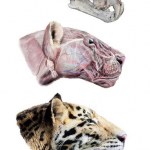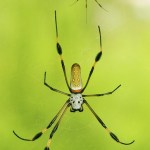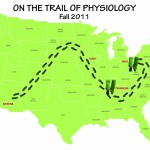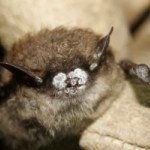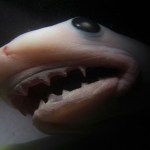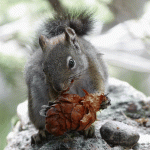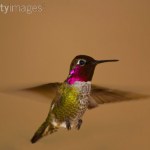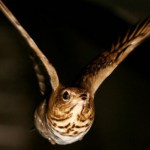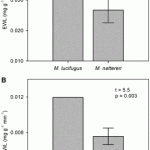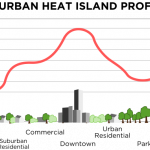Life Science
I am packing my bags for the joint meeting of the Iowa and Nebraska Physiological Societies. The meeting will take place October 21-22 at Des Moines University at the Olsen Medical Education Center. Can't wait!
I was just reading the National Geographic's Daily News and came across this article about the unearthing of a 2.5-million-year-old skull from a new species (Panthera zdanskyi) of tiger. What was interesting is that the skull of modern tigers is really not that different showing that the anatomy of tiger skulls have been ideal for the hunting needs of these animals for millions of years. That brings a whole new meaning to the phrase "if it isn't broken, don't fix it."
Photograph by Zach Holmes, Alamy
At least, that is the tactic that seems to work best for male golden orb-weaver spiders (Nephila pilipes). Researchers have now shown that these spiders will actually rub their partner's back to help calm her down and avoid being eaten after mating. Who doesn't like a good massage? You can watch a video of this process and read more here.
How would you like to have a Halloween costume that changed depending on your surroundings? Oh, to be a cephalopod. In our continuing talks about just how cool cephalopods are (including the cuttlefish, octopus, and squid), Remo sent us a link to this amazing video from Science Friday on the ability of the octopus to produce camouflage that you can view here.
Thank you Remo!
The next stop on our trail this Fall is the James H. Quillen College of Medicine at East Tennessee State University where the Tennessee Physiological Society will be holding their annual meeting tomorrow and Friday. You can check out the meeting agenda here. Can't wait!
What could be more interesting about ancient Egypt than the animal mummies? (personal opinion, of course)
Edward Bleiberg (Brooklyn Museum curator), Lisa Bruno (conservationist), and Anthony Fischetti (veterinary radiologist) have teamed up to scan 32 animal mummies that were housed at the museum using X-ray computed tomography (CT scans). You can read about this process and see photos here.
You will actually have a chance to see ancient animal mummies as part of the Eternal Life in Ancient Egypt exhibit set to open November 17th, 2011 at the Smithsonian National Museum of Natural History.…
First stop on the trail of physiology this Fall is the University of Cincinnati where the Ohio Physiological Society held their annual meeting last week.
Here are highlights from the meeting:
The meeting opened with a seminar from Dr. Ernest M. Wright from the UCLA-David Geffen School of Medicine. His presentation was on the development of new treatments for diabetes using inhibitors of sodium glucose cotransporters (SGLT). In the kidney, these transporters are responsible for preventing glucose from being disposed of in the urine by returning it to the blood. So inhibiting these…
It seems that octopuses are even smarter, and more fearless, than previously thought. It has been known for some time that they can be trained to open jars to obtain treats as shown in the promotional video for "Aliens of the Deep Sea" shown below:
There are even stories of them purposefully escaping their own tank to snack on fish in a tank nearby.
More recently, the animals have been discovered planning other complex activities. This video actually shows the animals collecting coconut shells, tucking them under their bodies and walking around with them to use for future defense against…
We received this interesting question from a reader regarding a previous post about the role of evaporative water loss in bats afflicted with white nose syndrome (WNS):
"Are bats during hibernation in ketosis? I suspect that normally they are not, that fatty acids are used to generate enough heat to keep warm, and the glycerine from the lipid is used for gluconeogenesis.
If they had insulin resistance, and needed more glucose or ketone bodies to supply tissue compartments that couldn't sustain themselves on fatty acids and had to incude ketosis, that could explain the starvation (ketosis is…
It is that time of year again when various chapters from The American Physiological Society hold their local meetings. I am looking forward to reporting the exciting news in physiology from these events!
The Ohio Physiological Society is having their 26th annual meeting October 6-7 at the University of Cincinnati. The keynote speaker will be Dr. Ernest Wright from the David Geffen-UCLA School of Medicine in Los Angeles, CA.
The Tennessee Physiological Society will be holding their annual meeting October 13-14 in Johnson City at the Quillen College of Medicine - East Tennessee State…
This video, captured by University of California Santa Cruz professor Giacomo Bernardi, shows an orange-dotted tuskfish (Choerodon anchorago) cracking open a clam by throwing it against a rock. Other fish from the wrasse family have also been observed using similar techniques to crack open clams. These include the blackspot tuskfish (Choerodon schoenleinii), yellowhead wrasse (Halichoeres garnoti), and a sixbar wrasse (Thalassoma hardwicke). Tool use among fish is not well-studied. For a fish to plan such an elaborate scheme (digging up the clam, finding a suitable rock to use as an anvil,…
Image source: Virgin Media
Sandtiger shark (Carcharias taurus) pups emerge from the womb as experienced killers. Since they develop teeth and the ability to swim while still in the womb, the strongest embryo will actually kill and eat its siblings (embryophagy) and their yolk sacs. This ensures that the surviving embryo has sole access to the unfertilized eggs that are continuously produced by the mother. Since they have two uteri, these sharks give birth to two live offspring whereas other shark species with less intrauterine killing instincts may deliver a brood of up to a dozen or so. In…
I am always amazed by stories of people who hoard animals and find myself mesmerized by the TV series dedicated to this important animal welfare issue. The animals found in these situations are often very ill due to squalid living conditions and lack of adequate food or water.
What I want to focus on, however, is another type of hoarding...food. Probably the best known example are squirrels like the Tamiasciurus hudsonicus, i.e. red squirrel, shown below which hoard food in preparation for the long winter fast:
Photograph: Steve Geer/iStockphoto.com.
Photo Credit: EcoRover
People and…
...or rather their squeak in some cases.
Male hummingbirds, like the Anna's hummingbird shown above, perform impressive dive bombs to attract females. During the dive, the birds spread their tail feathers to produce a loud squeaking or trilling noise. In this neat video from Dr. Christopher Clark, you can watch dive bombs and listen to the noises the birds make during these acrobatic flights. He presents his latest research on how the tail feathers affect the sounds produced during flight in a wind tunnel.
A reader sent in this question regarding our continuing conversation about how birds burn proteins to conserve water during long distance migrations:
"It's not immediately clear to me how burning intracellular proteins is going to automatically "free up" much water. I do know that burning fat makes more metabolic water, from scratch, per gram fuel burned. But I haven't read the paper." -Sven
So we asked Dr. Christopher G. Guglielmo to provide a response and here is what he had to say:
"Dear Sven, Thank you for your comment and you are correct that on a dry mass basis oxidation of fatty acids…
Image Source: Science/AAAS
You may recall a previous blog entry on how birds may be burning proteins to conserve water during long distance migration. I was delighted to hear more about this exciting research on NPR's Weekend Edition this past Saturday. You can listen to the story here.
To read more about Dr. Guglielmo's exciting research, read this feature in Science Magazine.
Image Source: Smithsonian Institution
As mentioned in previous posts, white nose syndrome is responsible for the decimation of hibernating North American bats. The cause of death is starvation attributed to increased arousal when the bats should be hibernating.
Dr. Craig K.R. Willis and colleagues have published new findings supporting the plausibility of " the dehydration hypothesis", that infections on the wing membranes of bats leads to dehydration thereby increasing the frequency of arousals. They found that the rate of evaporative water loss (EWL) was higher for a species that is most…
I would never have guessed that the weapon of choice for a humpback whale is bubbles. Lots of bubbles. Researchers have found that these whales create what are called "bubble nets" around schools of fish. The fish see the tiny bubbles as a barrier that they cannot cross. The whales then swim through the barrier and feast on the trapped fish.
If only my fishing pole could be that successful.
Image Source: National Oceanic and Atmospheric Administration (NOAA)
Cities and towns tend to be hotter than surrounding rural areas creating what are called urban heat islands. In a recent study, leaf-cutter ants (Atta sexdens rubropilosa) living in cities were found to have a higher heat tolerance than those living in rural areas (Angilletta et al., PLoS One 2(2): e258). Figure 3 from the article (below) shows urban ants (black lines) tolerating longer exposures to heat (42°C) than ants from rural areas (grey lines).
Researchers are unsure whether this adaptation in ants is a result of…
A dolphin has been given a prosthetic tail after she severely injured hers in a crab trap. You can watch the video of her story here. The story of the dolphin called "Winter" is so inspiring that a movie is being made of her incredible story called "Dolphin Tale". You can see the preview here. It opens in theaters September 23rd. This is an incredible story of the capacity for animals to recover from traumatic injuries.
